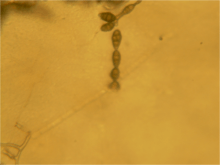Alternaria alternata
| Alternaria alternata | |
|---|---|
 | |
| Scientific classification | |
| Kingdom: | Fungi |
| Phylum: | Ascomycota |
| Class: | Dothideomycetes |
| Subclass: | Pleosporomycetidae |
| Order: | Pleosporales |
| Family: | Pleosporaceae |
| Genus: | Alternaria |
| Species: | A. alternata |
| Binomial name | |
| Alternaria alternata (Fr.) Keissl. (1912) | |
| Synonyms | |
|
Alternaria fasciculata (Cooke & Ellis) L.R. Jones & Grout (1897) | |
Alternaria alternata is a fungus which has been recorded causing leaf spot and other diseases on over 380 host species of plant. It is an opportunistic pathogen on numerous hosts causing leaf spots, rots and blights on many plant parts. It can also cause upper respiratory tract infections[1] and asthma in humans with compromised immunity.
Identification
Teleomorph
Unknown
Anamorph
Conidiophore
- Pale brown to olive brown
- 25–60 x 3–3.5 µm
- Straight or flexuous
- Individual conidiophores arise directly from substrate forming bushy heads consisting of 4–8 large catenate conidia chains
- Secondary conidiophores are generally short and 1-celled

Alternaria alternata spores in a chain

Alternaria alternata spores
Conidia
- Pale brown to light brown
- Obclavate to obpyriform orellipsoid, short conical beak at the tip, or beakless
- Surface smooth to verruculose
- Size
- 20–63 x 9–18 µm in size
- (on PCA) mature conidia typically 10–30 x 5–12 µm
- Septa
- Several vertical and −8 transverse septa
- (on PCA) 3–7 transepta, 1–5 longisepta
- Chains
- Produced in an often branched, long chain more than 5 conidia.
- (on PCA) individual chains of 5–15 conidia, complex of branching chains may contain up to 50–60 conidia
References
- ↑ Wiest, Peter; Wiese, Kurt; Jacobs, Michael R.; Morrissey, Anne B.; Abelson, Tom I.; Witt, William; Lederman, Michael M. (August 1987). "Alternaria Infection in a Patient with Acquired Immunodeficiency Syndrome: Case Report and Review of Invasive Alternaria Infections". Reviews of Infectious Diseases (The University of Chicago Press) 9 (4): 799–803. doi:10.1093/clinids/9.4.799. JSTOR 4454171. PMID 3326127.